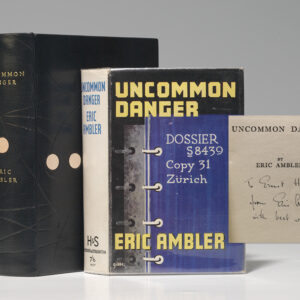Description
“TO OBTAIN FINE CLEAN COPIES OF THIS BOOK HAS BEEN THE UNSUCCESSFUL QUEST OF MANY BOOK COLLECTORS”: THE RARE FIRST EDITION OF DICKENS’ CLASSIC, GREAT EXPECTATIONS, IN THE EXCEPTIONALLY RARE ORIGINAL CLOTH
DICKENS, Charles. Great Expectations. London: Chapman and Hall, 1861. Three volumes. Octavo, original blind- and gilt-stamped blue cloth. Housed in a custom cloth clamshell box.
First edition in book form, first impression, of one of Dickens’ most beloved and scarcest novels, one of only 1000 copies printed, in the exceptionally rare original cloth-gilt.
In Great Expectations, Dickens allowed “all the previously inchoate and shadowy fears of his childhood… to emerge without impediment… He could not have hoped for a warmer reception than the book actually received…” (Ackroyd, 900- 902). “Great Expectations originally appeared in 36 weekly numbers of All the Year Round from 1 December 1860 through 3 August 1861. It appeared in the three-volume book form on July 6, 1861… The rarity of the first issue of Great Expectations has been attributed to the probable small binding-up of copies with the first title page [only 1000 copies of the first issue were printed], coupled with the fact… that the first edition was almost entirely taken up by the libraries” (Smith 14). It is Dickens’ only novel, apart from Hard Times, that was not illustrated in its first book form and one of only two novels never issued in parts. “To obtain fine clean copies of this book has been the unsuccessful quest of many book collectors” (Eckel). First edition, first impression, published on July 6, 1861. The first edition was divided into five impressions, with distinct title pages, perhaps to imply rapid sales. The modern bibliographical authority is generally agreed to be the table given in Appendix D to the Clarendon edition, 1993, based on line-by-line collation of six 1861 copies, with additional spot checks from other copies, in which Margaret Cardwell agrees with the traditional conclusion that the same setting of type was used for all five impressions: “there is no warrant for treating the five impressions as distinct editions” (p. 491). However, she deduces that the impressions were sequential and that minor corrections and gradual deterioration of type can be shown across the five impressions. This copy has most of Cardwell’s points for the first impression, except for a few that are believed to indicate variant states rather than a subsequent impression or issue. Points not present are: Vol. II, page 39, line 5 (no ink between “you” and “feel); Vol. III, page 192 (“himself very / ” rather than himself / very”) suggesting a very early change by the typesetters; Volume III, page 193 with the middle “I” in “III” not faint. With 32 pages of publisher’s ads at end of Volume III, as seldom. Patten states that 1000 copies of the first impression were printed and that probably most of these copies were purchased by Mudie’s Select Library where, as circulating library copies, the inevitably suffered a high rate of attrition, leading to their renowned rarity. This copy is definitely one of these copies from Mudie’s library (as with the Sadlier copy) with a faint shadow of removed labels to the front covers and with Vols. I and III bearing yellow “Recent works of Fiction in circulation at Mudie’s Select Library” labels affixed to rear pastedowns. Following sale by Mudie’s the volumes entered the Mutual Improvement Society of St. Mary Tavy in Devon, inscribed on the front pastedowns as such, and numbered 149, 150 and 151 with a loan period of 14 days. Smith 14. Eckel, 91-93.
Only a few finger smudges and creased corners to interior, open tears to marginal corners at Vol. II, pages 137 and 283, wear and soiling to original cloth, joints hinges, and extremities discreetly and expertly restored, gilt slightly worn. A very good copy, much nicer than usually found.



